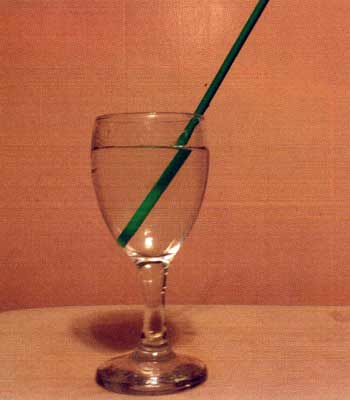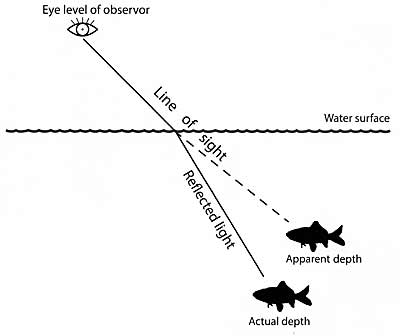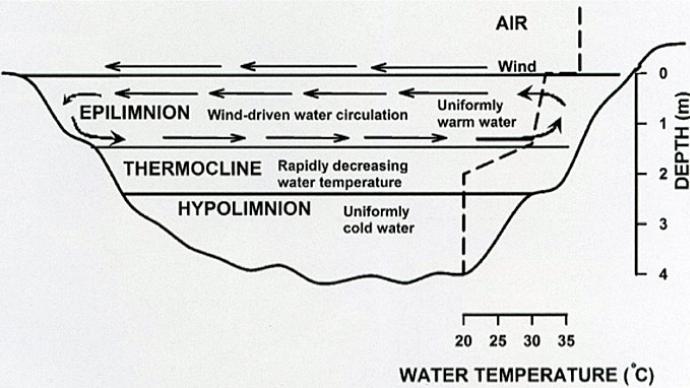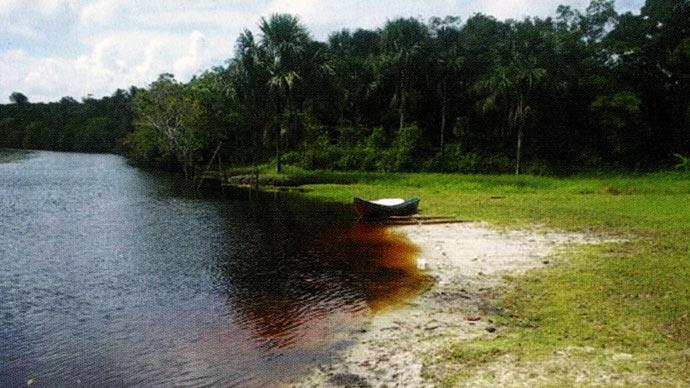
Once I went to Queen's University in Kingston, Ontario, Canada to give a lecture. My host and three of his students took me for a boat trip in a very clear lake. They threw out the anchor when I was not watching, but when it was discovered that the anchor was stuck under a large log, I watched while they tried to retrieve the anchor. The anchor appeared no more than about five feet beneath the boat. I asked why not use the long oar on board to dislodge the anchor or jump in and retrieve it. The answer - the water is over 20 feet deep here. I was surprised by the answer and proceeded to lower a Secchi disk on a long line-they were correct, and they had to sever our connection to the anchor and leave it there.
Many of you probably have already noticed that underwater objects appear to be at a shallower depth than they actually are when viewed from the edge of a pond or from a boat. This phenomenon is the result of the refraction of light by water. Some might enjoy reading about how refraction of light is responsible for this phenomenon.
Light travels at the speed of light (186,000 miles/second) in a vacuum, but in air or other media of greater density, it travels at a slower speed. Thus, when light passes from of different density, it either slows down, if the second medium is denser than the first, or it speeds up if the second medium is less dense than the first. Water is denser than air, and when light passes from air into water it refracts toward the normal (real or imaginary line perpendicular to the water surface). Of course, the opposite event occurs when light travels from water into the air (the refraction is away from the normal).

Although many may not realize it, almost everyone has seen proof that water refracts light. When you look from the side at a glass of water containing a drinking straw, the part of the straw extending into the water appears to be offset from the part of the straw extending from the water (Fig. 1). This discontinuity in the visible image of the straw is the result of the refraction of light by the water.
Our eyes do not send out light, but they allow us to see reflected light. Thus, when we see a fish in the water, we see the light reflected by the fish, and as a result, we can see the image of the fish.
The illustration in Fig. 2 reveals why a fish in the water appears at a lesser depth than it is perceived to be by an observer on the pond bank. The observer sees light reflected by the fish. This reflected light from the fish speeds up upon entering the air, and this causes the reflected light to refract (bend) away from the normal. The observer's line of sight is not subject to refraction, and this causes the fish to appear at a lesser depth than it truly is.
Most pond owners have freshwater in their ponds and seldom are concerned with salinity (the total concentration of dissolved inorganic ions in water). However, if one desires to measure the salinity of water, the refraction of light allows it to be done by simple means. Water has a refractive index that depends to a small extent on its temperature. Liquid water increases in density from 0°C to 3.98°C, and it decreases in density at higher temperatures because the volume of a given weight of water expands at temperatures above 3.98°C. Salts, on the other hand, increase the density of water, because particles of dissolved salts displace their volume of water. For example, 1 gram of table salt with a density of 2.16 g/cm3 will displace only 0.46 cm3 of water, thereby increasing the density in a salt-water solution.

The greater density causes water to refract light more, and the change in refraction (or refractive index) is related to the concentration of salts (salinity).
A hand-held refractometer (Fig. 3) is made by recalibrating in salinity units the scale for refraction of light. The salinity is measured simply by viewing the salinity scale in the instrument after adding a drop of water to the plate on the instrument. This device is in common use by keepers of marine aquaria, and the concept is used to measure the density of many other liquids. There are practical uses of the refractive index.
Dr. Claude Boyd is a professor emeritus in the School of Fisheries, Aquaculture and Aquatic Sciences, Auburn University, Auburn, Alabama 36849. His work with water quality is internationally renowned. His most recent book, Handbook for Aquaculture Water Quality, is a must for anyone interested in learning about water chemistry and how it relates to your pond. It's technical, thorough, but easy to read and understand. Buy it at www.pondboss.com in the online store.



